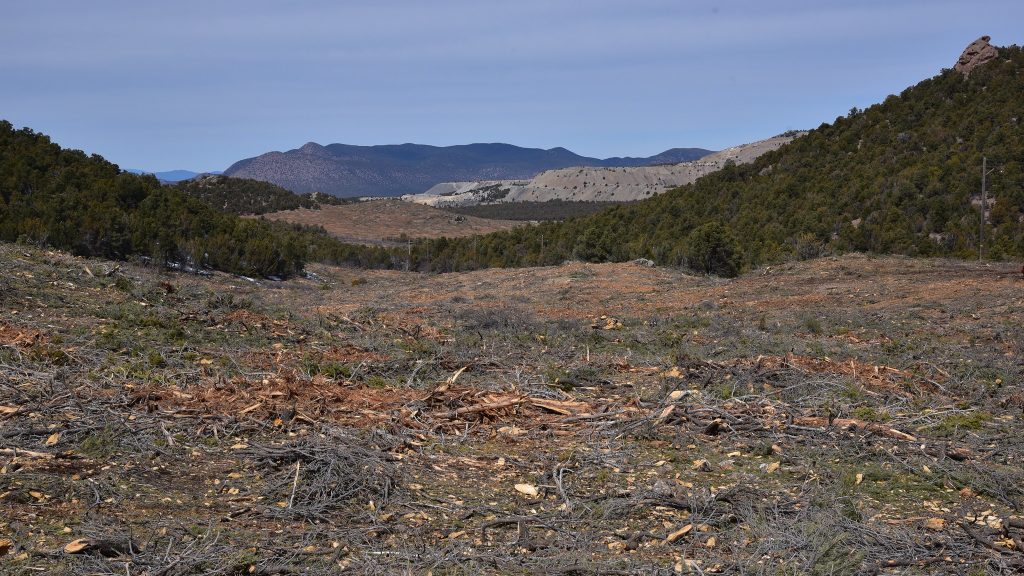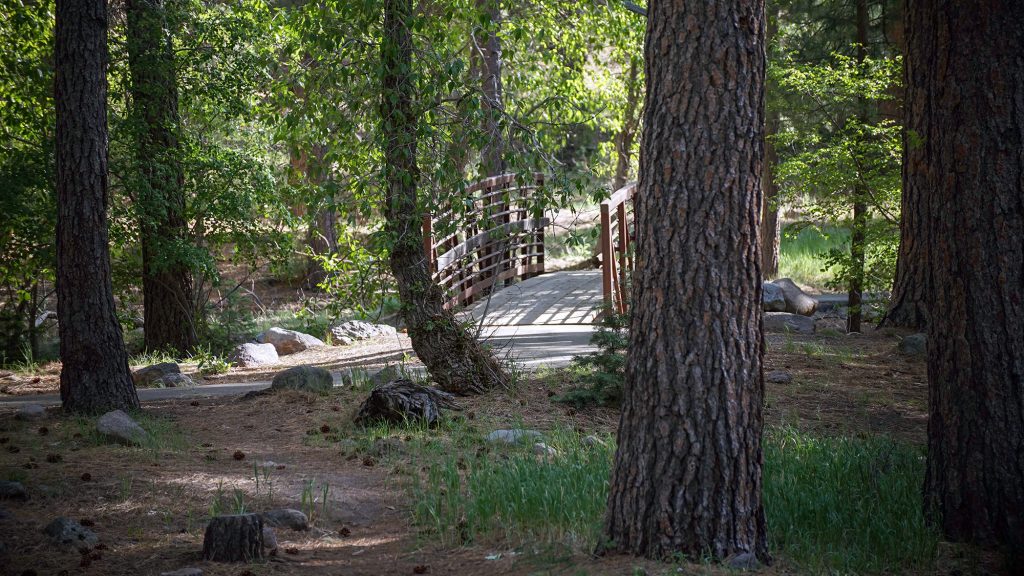ST. GEORGE — To combat the wildfire crisis, the U.S. Forest Service is funding projects in high-risk locations. In Southern Utah, the agency chose the Pine Valley landscape, a lower-elevation, mountainous area where visitors enjoy the rugged wilderness, towering pinyon pines and fragrant juniper trees.

The Forest Service launched a 10-year plan to address the wildfire crisis in January 2022, according to its website. The strategy focuses on the “places where (wildfire) poses the most immediate threats to communities” and “combines a historic investment of congressional funding with years of scientific research” to increase the scale of forest health treatments.
“Through the strategy, the agency will work with states, Tribes, and other partners to address wildfire risks to critical infrastructure, protect communities, and make forests more resilient,” the site reads.
Dixie National Forest Supervisor Kevin Wright told St. George News that the number of wildfires has increased and that these fires behave more erratically.
To that end, 10 priority landscapes were chosen in 2022 to begin mitigating “the effects of catastrophic wildfires,” he said.
Continuing this work, the U.S. Department of Agriculture’s Secretary Tom Vilsack and Forest Service Chief Randy Moore announced the addition of 11 priority landscapes. Projects will be funded via the Bipartisan Infrastructure Law and the Inflation Reduction Act to reduce wildfire risk throughout the west.
The Forest Service found that approximately 80% of wildfire risk is concentrated on less than 10% of firesheds, Wright said. Firesheds are areas where a wildfire would likely threaten communities and infrastructure.

Using the “best available science and data,” Wright said the Forest Service has identified about 250 high-risk landscapes in the west and has plans to treat approximately 134, spanning 45 million acres.
In 2023, the agency will invest $930 million on projects within 21 landscapes across 26.7 million acres, according to this news release. The work “will mitigate risk to approximately 200 communities.”
Priority landscapes have been designated in southwest Idaho, the Intermountain Region, and the Uinta-Wasatch-Cache, Dixie and Humboldt-Toiyabe national forests. In Southern Utah, the Forest Service is undertaking the Pine Valley Priority Landscape Project.
Gov. Spencer Cox said in the release that the decision was “excellent news.”
“The best way to prevent catastrophic wildfires is to actively and aggressively manage our forests, which takes money and focus on the areas that need it most,” he said. “Secretary Vilsack and I have talked extensively about this topic for the past two years, and I’m thrilled with these investments.

“Better forest management means fewer and milder fires, which means lives and homes saved, cleaner air and water, more water in our reservoirs, and healthier forests for Utahns to enjoy.”
Due to its low elevation and topography, Pine Valley is highly susceptible to “climate change and shifting fire patterns, creating an urgent need to reduce the risk of catastrophic wildfire,” this informational document states.
The area is adjacent to St. George, encompassing approximately 250,000 acres of land in the Pine Valley Ranger District of the Dixie National Forest and 150,000 acres of private, state and federal land, according to the project’s website.
The Forest Service plans to treat approximately 6,554 acres in Pine Valley in 2023, 10,870 in 2024 and between 50,000-80,000 over the next seven to 10 years.
“There’s always been fire on that landscape,” Wright said, adding that the Forest Service has done work in the area for years, investing large amounts of funding in reducing risk to nearby communities, including Pinto, Enterprise, Central and Pine Valley.

Key infrastructure at risk includes major gas and power lines and the Pine Valley Recreation Area.
Additionally, the agency is interested in protecting the “landscape of Pine Valley itself,” Wright said, adding that wildfires threaten wildlife habitat, watershed health and water quality. With the “influx of money,” they can “treat the landscape at a scale where we can make a bigger difference in protecting those values.”
The effort will include mechanical treatments, where workers use track hoes fitted with masticator attachments to chop trees “into pieces,” which are spread across the ground, Wright said. The Forest Service will also use a technique called hand thinning, which uses chainsaws to cut down small trees and scatter the remaining material on the landscape.
Both treatments reduce ladder fuels — materials that can carry a fire from low-growing vegetation to taller plants, like trees. Wright said this would allow the firefighters to combat fires on their own terms.
“We get to dictate what the fire does rather than fire dictating to us what it’s going to do,” he said.

Additionally, the material provides ground cover for new seeds and the soil, which will decrease erosion potential, Wright said, adding that the diversity and landscape composition in these areas often “look different and get healthier.”
Wright said that Forest Service crews are familiar with the work, landscape and potential challenges, and he isn’t expecting any major roadblocks.
“It’s work we’ve done, just at a larger scale now,” he said.
A large portion of the priority landscape is included in the Pine Valley Wildlife Habitat and Ecological Resiliency Improvement Project, which was initiated last year, Wright said. The improvement project will encompass 181,575 acres of the Pine Valley Ranger District.
Six conservation groups, including the Grand Canyon Trust and Southern Utah Wilderness Alliance, jointly commented on the improvement project, stating that they appreciate the Dixie National Forest’s efforts to engage the public on the project, including incorporating some proposals they made previously.
And while they recognize the potential value of “ecologically-informed, landscape-scale restoration efforts,” they believe the project and its environmental analysis “require substantive modifications.”

Additionally, “decades of fire suppression, livestock grazing and other human impacts have resulted in unhealthy ecosystems and fuel loads,” Laura Welp, the vegetation projects director at the Western Watershed Project, told St. George News.
“Action is needed to restore natural fire regimes and ecosystem processes to meet the urgency of the climate crisis,” she said. “However, these projects must be well-planned, based in science and transparent. That has not always been the case, as unsuccessful past treatments show.
“We need projects that foster long-term sustainability, which requires considering how to reduce human impacts and objectively analyzing the role of livestock management in perpetuating unhealthy landscapes.”
Because the landscape’s conditions pose a fire risk, Welp said the Forest Service is acting responsibly in addressing the issue and “doing it pretty quickly.” Still, she urges the agency to conduct site-specific assessments “that would really inform the public about what kinds of impacts you’re going to be incurring.”
Depending on a specific site’s characteristics, tree thinning can do “more harm than good” and “cause a lot of damage” due to impacts on vegetation and soil, and a lack of proper livestock management following treatment, Welp said. For instance, cattle trampling native plants or weeds growing before new seeds can germinate, are potential risks in some areas.

Some native species, such as the pinyon jay, could also be affected by these projects. The decline of pinyon pine impacts the birds’ population, Welp said. So stewarding agencies should be mindful of where the jays are nesting, breeding and traveling to avoid removing trees they rely on to survive.
“Nobody wants to list anything under the Endangered Species Act,” Welp said. “So you need to watch and make sure that what you’re doing is not going to impact them.”
While an environmental assessment is being completed for the improvement project, it doesn’t include the entirety of the priority landscape. Wright said the Forest Service would conduct any additional analyses required to meet their goals.
These could include environmental assessments and environmental impact statements, as required under the National Environmental Policy Act.
For more information about priority landscapes and the Forest Service’s efforts to reduce wildfire risk in the Western U.S., follow this link. To learn more about the Pine Valley Priority Landscape Project, click here.
Photo Gallery
The Pine Valley landscape’s low elevation and topography make it susceptible to shifting fire hazards and climate change, creating an urgent need to reduce the risk of potentially catastrophic wildfire, Pine Valley Mountain Wilderness, Utah, date not specified | Photo courtesy of the U.S. Forest Service, St. George News The U.S. Forest Service uses mastication and heavy equipment to complete work to remove Pinyon and Juniper trees in the Pine Valley Priority Landscape area, Utah, Feb. 28, 2020 | Photo courtesy of the U.S. Forest Service, St. George News The U.S. Forest Service uses mastication and heavy equipment to complete work to remove Pinyon and Juniper trees in the Pine Valley Priority Landscape area, Utah, Feb. 28, 2020 | Photo courtesy of the U.S. Forest Service, St. George News The U.S. Forest Service uses mastication and heavy equipment to complete work to remove Pinyon and Juniper trees in the Pine Valley Priority Landscape area, Utah, Feb. 28, 2020 | Photo courtesy of the U.S. Forest Service, St. George News The U.S. Forest Service uses mastication and heavy equipment to complete work to remove Pinyon and Juniper trees in the Pine Valley Priority Landscape area, Utah, Feb. 28, 2020 | Photo courtesy of the U.S. Forest Service, St. George News The U.S. Forest Service uses mastication and heavy equipment to complete work to remove Pinyon and Juniper trees in the Pine Valley Priority Landscape area, Utah, Feb. 28, 2020 | Photo courtesy of the U.S. Forest Service, St. George News The U.S. Forest Service uses mastication and heavy equipment to complete work to remove Pinyon and Juniper trees in the Pine Valley Priority Landscape area, Utah, Feb. 28, 2020 | Photo courtesy of the U.S. Forest Service, St. George News The U.S. Forest Service uses mastication and heavy equipment to complete work to remove Pinyon and Juniper trees in the Pine Valley Priority Landscape area, Utah, Feb. 28, 2020 | Photo courtesy of the U.S. Forest Service, St. George News







Copyright St. George News, SaintGeorgeUtah.com LLC, 2023, all rights reserved.


